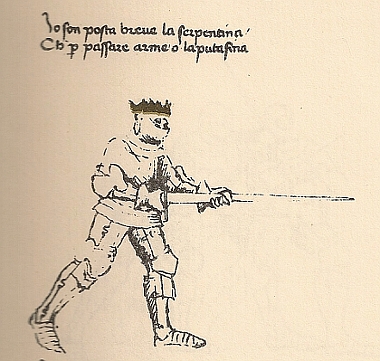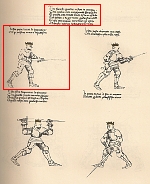
| Fiore dei Liberi: Flos Duellatorum, 1410 (Pisani-Dossi, F. Novati, Bergamo, 1902) |
| 5 spada longa in arme - armoured longsword |
| 5.0 poste (guards) |
| 5.0.1 posta breve, la serpentina (guard of the short serpent) |
| Io son posta breve, la serpentina, Che per passare arme la punta fina |
| I am the guard of the short serpent, A sharp point which will pass through armour |
Synopsis:  The name la serpentina implies that the movement is comprised of quick thrusts and cuts, such as is the movement observed of a striking snake or serpent. The thrust is delivered and re-coiled immediately for a follow-up strike and possibly repeated again, somewhat like jabs. The verse comments on the effectiveness of thrusting against armour.
The name la serpentina implies that the movement is comprised of quick thrusts and cuts, such as is the movement observed of a striking snake or serpent. The thrust is delivered and re-coiled immediately for a follow-up strike and possibly repeated again, somewhat like jabs. The verse comments on the effectiveness of thrusting against armour.
Practical Application: Liberi describes this efficient guard with only a single purpose in mind, it is quick/fast. It is clear that the principle purpose of this guard position is to deploy thrusts which may or may not deliver a mortal wound, but provides the opportunity of the thruster to engage in close-quarters by pressing in due to the distractions to the opponent caused by his/her receiving a quick succession of thrusts. Should the thrusting point be planted well on the opponent as he/she steps forward ("sticky point"), the thruster can then easily terminate the engagement with a forceful thrust, or engage with cross-swords and therefore, close-quarters.
This same guard can also be used as an entry into close-quarters combat by simply transitioning to the guard of the true cross by placing the blade against the opponent's blade resulting in the crossing of swords. This is accomplished by arching outwards and forward of the right hand pivoting against the left hand gripping on the blade (guard of the bastard cross) and stepping forward to press in onto the opponent. It is expected that this manner of movement is deployed when the opportunity presents itself which may have been setup previously with the principle purpose of posta breve, la serpentina.
Secondly, because of the grip on the blade, the foible is very fast and can deliver quick cuts in a circular motion in order to attempt to hook the opponent's blade effectively setting it aside quickly followed immediately with a thrust or engage in giocco stretto.
Grip: For the purpose of clarity, the grip configuration is explicitly described. Right hand: palm down, thumb forward (inside); Left hand: palm up, thumb forward (outside). This is consistent with the illustration in the Getty's version. This posta leads to an easy transition to the posta di vera croce in terms of posta to posta transitions.
The following text on the same plate is an introduction to these plates found in the treatise, which is indicated in the figure above right. The following text appears on the first page of the longsword portion of the treatise, and is included here for interest purposes including its translation.
| Noy semo sei guardie in lato de armiçar, Che quella arte integrament sauemo far, E questa arte conclude in tuto la drita ueritade, Aça, spada e daga mete in grande stremitade, E qui parlaremo como l'arte pó uenir, Magistri e scolari lo farano a non mentir |
| We are the six general guards for armoured combat, Which we know the skills of this art completely, And these arts end in all true methods, Axe, sword and dagger in great expertise, And here we will explain a little how this art works, The masters and students will do so without falsehood |
| Anonymous, Cod 11093 | c1440 | pflug |
| Anonymous, Gladiatoria | 1425-1475 | pflug - variation |
| Hans Talhoffer, Fechtbuch aus dem Jahre 1467 | 1467 | gewappnete ort |